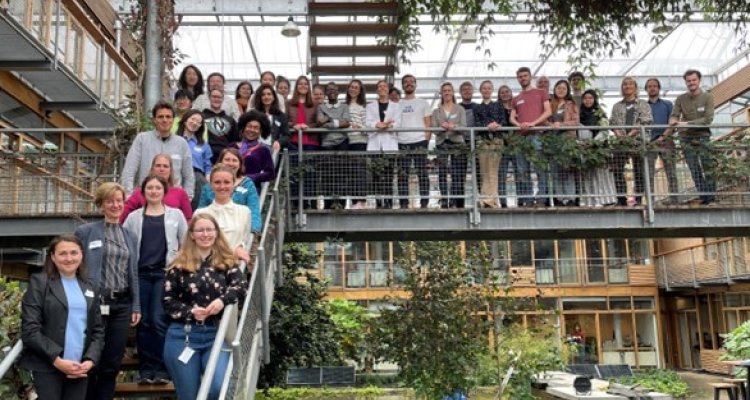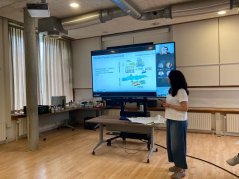
News
Plastics @ WUR: let’s team up for a sustainable future with fewer plastics
For the 4th time, the Wageningen plastic team gathered to talk about plastic-related issues. The team consists of about 45 scientists from a variety of science groups representing different disciplines. When talking about plastics, it quickly became clear that there is a wide variety of issues, but also a huge drive to understand and solve them! Plastics are largely embedded in research at Wageningen University & Research (WUR). A quick search shows over 3,000 research outputs and over 408 people linked to plastics at WUR (Search everything — Research@WUR). Yet, there are many opportunities for collaboration to explore. Hence, this was our aim for the 4th WUR Plastic Day. The very interactive programme included warm-up exercises, pitches, discussion carrousels, presentations and opportunities for informal chats. In this newsitem, our colleague Mirjam Bak would like to give you an impression of the 4th WUR Plastic Day following the four main discussion topics of the day and by sharing some of her personal takeaways.

The plastic cycle
Plastics are part of multiple environmental systems (e.g. soil, air or water) which are connected through a cycle of sources, transport processes and impact. The different research groups at WUR can be linked to specific parts of this plastic cycle. The policy and technology groups, for example, could minimise the plastic impact through a reduction in plastic sources. Another example is our need to understand the characteristics of plastics in different environmental systems. To fully understand and potentially close the plastic cycle, we need to oversee all connections and knowledge gaps. During the discussions, it became clear that, if we want to see this bigger picture, we need to talk the same language. Steps that we can take to get there are related to shared facilities, visions, databases and protocols.
Shapes and sizes
Macroplastics, mesoplastics, microplastics and nanoplastics, are all names to refer to the sizes of plastics (i.e. large to small) that are being researched. However, different researchers use different definitions. Does this call for the introduction of rigid definitions? On one hand, rigid definitions might lead to better communication and might facilitate interdisciplinary studies. On the other hand, formulating rigid definitions that everyone agrees on can take up excessive amounts of time. In addition, other factors such as the shape, type and volume of the plastics cannot be ignored. Sounds complex, doesn’t it? A key takeaway from this discussion was that aside from whether we have rigid definitions or not, interacting with fellow scientists remains key. Whether it is in a joined plastic laboratory or group meetings like the WUR Plastic Day.
Interdisciplinarity is pivotal
At WUR we study plastics in multiple ways. For instance, we study them in the natural systems (i.e. how they enter the soil) or within the social system (i.e. how our consumption affects plastic pollution). We can study them using projections from computer models or we can study them via monitoring studies in the field. Hence, many scientists from different disciplines are involved and their research may be intertwined. We can strengthen our linkages within WUR using a common objective. Additionally, we need to foster our connections with society, industry, governments and policymakers. Luckily, we had the pleasure of having Paul Vriend from Rijkswaterstaat (i.e. part of the Dutch Ministry of Infrastructure and Water Management) as a guest speaker during the 4th WUR Plastic Day. Paul gave us insights into the science-policy interface. Next to this, Paul had some useful tips for collaborating with non-academic parties. An example of this is Paul’s explanation of the different types of collaboration opportunities with Rijkswaterstaat. The questions from the audience and their informal talks after Paul’s presentation, tells his talk was a success!
Closing the tap
After talking about plastics all day, the urgency of closing the plastic tap feels even bigger. But how we are going to do this and when can we stop dwelling? Do we need to recover landfill, redesign materials, redesign policy, re-behave, or perhaps even re-earth or re-future? Redesigning the future sounds tempting, but also very complex. Happily, as scientists, we can also take smaller, concrete steps towards a sustainable future with fewer plastics. Examples of such steps are: producing a plastic podcast, building a strong network, writing joint papers and proposals, and improving science communication skills.
Mirjams takeaways
For Mirjam, there are three personal takeaways from this day. First, being together in an interactive setting shows how easily new knowledge is exchanged. For example, she never considered distinguishing between active and passive plastic transport. With active plastic transport, we refer to the plastic that is moved by animals or humans. This is different from passive transport by rivers. Second, there is a high need and wish for more collaboration within WUR – and collaborations are fun. Opportunities for this could be in joint PhDs, laboratories or funding. Third, to make an impact as scientists we need to invest in societal outreach. For this, we can learn from each other and communication experts. Full of new ideas, Mirjam is looking forward to the next WUR Plastic Day.